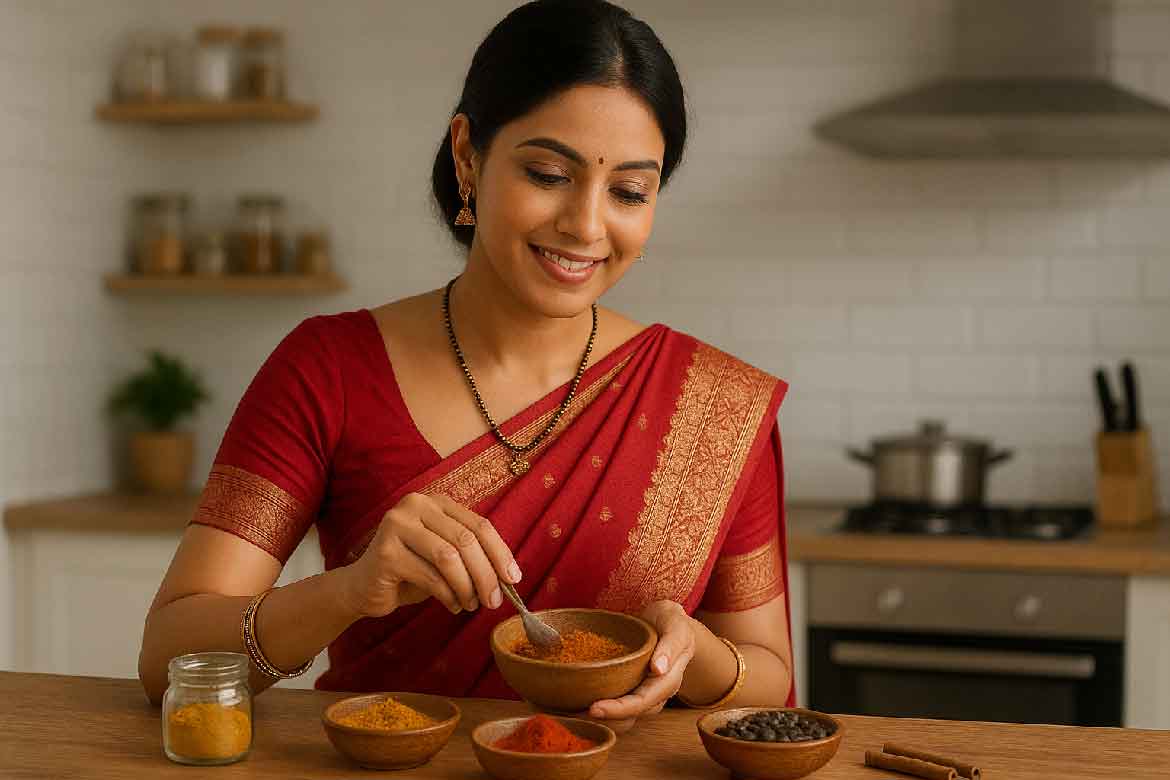Blog
Pairing Spices Like a Pro: A Beginner’s Guide

Spices are the heart of cooking. They bring life, colour, and flavour to every dish. Without them, food can taste plain and uninspiring. With the right spices, even simple meals can feel special. Learning how to pair spices may feel overwhelming at first. But the truth is, anyone can do it.
This guide will help you understand spices and how to use them like a pro. We will explore flavour families, pairing rules, cultural spice blends, and practical tips. By the end, you will feel confident experimenting with spices in your kitchen.
Why Spices Matter in Cooking
Spices are not just flavour boosters. They also carry culture, tradition, and health benefits. From turmeric in India to cinnamon in Sweden, spices tell stories of history and trade.
Here are reasons why spices matter:
- Flavour enhancement: Spices make food exciting.
- Aromatherapy: Their smell can uplift mood.
- Health benefits: Many spices aid digestion and boost immunity.
- Cultural identity: Every cuisine has signature spice blends.
Spices turn everyday cooking into a meaningful experience.
Understanding the Basics of Spices
Before learning pairings, it helps to know what spices are. Spices come from plant parts like seeds, roots, bark, and fruits. Examples include cinnamon (bark), cumin (seeds), and ginger (root).
Difference Between Spices and Herbs
- Spices usually come from dried seeds, bark, or roots.
- Herbs are green leaves like basil, mint, and parsley.
Together, they build flavour. Herbs add freshness, while spices add depth.
Categories of Spices
Spices can be grouped by their dominant flavour. Understanding these categories makes pairing easier.
- Warm spices: Cinnamon, nutmeg, cardamom, clove.
- Earthy spices: Cumin, turmeric, coriander, fenugreek.
- Pungent spices: Black pepper, mustard seeds, ginger.
- Sweet spices: Vanilla, star anise, fennel.
- Smoky spices: Smoked paprika, chipotle.
- Bitter spices: Mace, fenugreek, turmeric (in large amounts).
Every spice family has its role. Using a balance keeps dishes harmonious.
Golden Rules of Spice Pairing
When learning to pair spices, a few golden rules can guide you:
- Balance flavours: Mix bold spices with softer ones.
- Start small: Use a pinch before adding more.
- Think of culture: Pair spices commonly used in a cuisine.
- Consider cooking time: Whole spices need more time to release flavour.
- Taste as you cook: Adjust along the way.
These rules make pairing feel less intimidating.
Common Spice Pairings for Beginners
Some spices naturally complement each other. Here are a few tried-and-true pairs:
- Cumin + Coriander: Earthy and citrusy, perfect for curries.
- Cinnamon + Nutmeg: Sweet and warm, great for desserts.
- Ginger + Garlic: Pungent and savoury, used worldwide.
- Mustard Seeds + Turmeric: A classic in Indian cooking.
- Black Pepper + Lemon Zest: Sharp and fresh, ideal for seafood.
- Paprika + Chili Powder: Smoky with heat, used in Mexican dishes.
These pairs can instantly make your food more flavourful.
Building Spice Blends
One advanced way to use spices is by creating blends. These blends form the base of global cuisines.
Popular Spice Blends
- Garam Masala (India): Cumin, coriander, cinnamon, cloves, cardamom.
- Za’atar (Middle East): Thyme, sesame seeds, sumac.
- Ras el Hanout (Morocco): Over 20 spices, including cumin, cinnamon, and nutmeg.
- Cajun Spice Mix (USA): Paprika, garlic powder, cayenne, oregano.
- Herbes de Provence (France): Thyme, rosemary, oregano, lavender.
You can start with small blends and expand as you gain confidence.
Pairing Spices with Different Foods
Different foods work better with certain spices. Let us break it down:
Vegetables
- Potatoes: Paprika, cumin, turmeric.
- Carrots: Cinnamon, ginger.
- Spinach: Nutmeg, garlic.
Meat
- Chicken: Paprika, oregano, turmeric.
- Beef: Black pepper, rosemary, cloves.
- Lamb: Cumin, coriander, cinnamon.
Seafood
- Fish: Dill, lemon zest, black pepper.
- Prawns: Chili, garlic, coriander.
Grains and Pulses
- Rice: Cardamom, saffron, bay leaf.
- Lentils: Cumin, turmeric, coriander.
Sweets
- Cakes: Cinnamon, nutmeg, vanilla.
- Chocolates: Chili, cinnamon.
This guide makes it easy to pair spices with the food you cook daily.
How to Experiment with Spices
Experimentation is key to becoming skilled at spice pairing. Here’s how to start:
- Choose one base ingredient (like chicken).
- Add one main spice (like paprika).
- Pair with one supporting spice (like cumin).
- Taste and adjust before adding more.
Keep a notebook of your spice experiments. Over time, you’ll see patterns.
Avoiding Common Mistakes
Beginners often make mistakes when using spices. Here’s how to avoid them:
- Don’t add too many spices at once.
- Don’t burn whole spices; roast them gently.
- Don’t use stale spices. Always check freshness.
- Don’t overpower delicate foods with strong spices.
Learning from mistakes is part of the process.
Storing Spices the Right Way
Storage affects spice quality. Poor storage makes spices lose flavour.
- Keep spices in airtight containers.
- Store them in a cool, dark place.
- Avoid moisture and direct sunlight.
- Buy in small quantities for maximum freshness.
Proper storage ensures every dish tastes vibrant.
Health Benefits of Common Spices
Spices are not just tasty; they also promote health.
- Turmeric: Reduces inflammation.
- Ginger: Aids digestion.
- Cinnamon: Balances blood sugar.
- Garlic: Boosts immunity.
- Black Pepper: Improves nutrient absorption.
Adding spices can support both flavour and wellness.
Cultural Spice Journeys
Exploring spices is like traveling the world. Each culture has a unique spice story.
- India: Known for layered spice blends.
- Middle East: Rich in warm spices like cumin and sumac.
- Mexico: Famous for chili and smoky paprika.
- China: Uses five-spice mix with star anise, fennel, and clove.
- Sweden: Loved for cinnamon and cardamom in baked goods.
Cooking with spices connects you to global traditions.
Beginner-Friendly Recipes to Try
Here are simple recipes for you to practice spice pairing:
Spiced Lentil Soup
- Spices: Cumin, turmeric, coriander.
- Method: Cook lentils with onions, garlic, and spices.
Cinnamon-Carrot Cake
- Spices: Cinnamon, nutmeg.
- Method: Mix grated carrots with flour, sugar, eggs, and spices.
Garlic-Paprika Chicken
- Spices: Garlic, paprika, oregano.
- Method: Rub chicken with spices and roast.
These recipes are quick wins for beginners.
Tips to Build Spice Confidence
- Smell spices before cooking to understand aroma.
- Roast spices lightly to unlock deeper flavour.
- Pair spices with herbs for balanced dishes.
- Watch how professional chefs use spice blends.
- Trust your taste buds.
Confidence grows with practice.
Why Buy Quality Spices
Not all spices are equal. Low-quality spices can be dull and lifeless. Fresh, high-quality spices make every dish shine.
Signs of quality spices:
- Strong aroma.
- Vibrant colour.
- Clean, pure taste.
Choosing the right source matters for your cooking journey.
Frequently Asked Questions (FAQs)
1. How do I start pairing spices as a beginner?
Start with one main spice and add one supporting spice. Taste as you cook and adjust slowly.
2. Which spices are best for beginners?
Cumin, coriander, cinnamon, paprika, turmeric, and black pepper are easy for beginners to use.
3. Can I mix many spices together?
Yes, but keep it balanced. Start with two or three spices. Too many can confuse flavours.
4. How do I know if spices are fresh?
Check the aroma and colour. Fresh spices smell strong and look vibrant. Dull ones may be old.
5. What is the difference between herbs and spices?
Herbs are green leaves like basil or mint. Spices come from seeds, bark, roots, or dried fruits.
6. Do spices expire?
Spices do not spoil, but they lose flavour over time. Replace ground spices every 6–12 months.
7. How can I store spices to keep them fresh?
Keep them in airtight containers, away from heat, sunlight, and moisture.
8. Which spice blends should I try first?
Try garam masala, Cajun mix, or Italian seasoning. These blends are simple and versatile.
9. What foods pair well with cinnamon?
Cinnamon pairs well with apples, carrots, sweet potatoes, cakes, and even hot chocolate.
10. Why should I buy spices from Xyra Foods?
Xyra Foods offers premium, fresh, and natural spices. They bring out the best flavour in every dish.
Conclusion: Cook with Confidence, Choose Xyra Foods
Pairing spices is a skill you can master with practice. Start small, balance flavours, and explore global traditions. Spices can transform your cooking and bring joy to your meals.
At Xyra Foods, we offer premium spices, cereals, and more. Our products are fresh, natural, and carefully sourced. Whether you are a beginner or a seasoned cook, our spices will elevate your dishes.
Bring flavour, health, and happiness into your kitchen. Buy your spices, cereals, and pantry essentials from Xyra Foods today.

